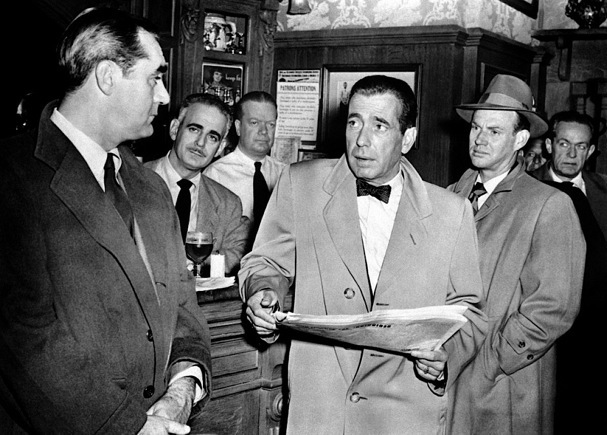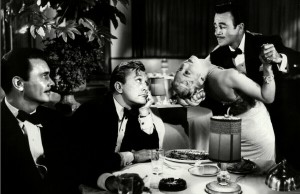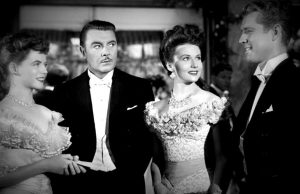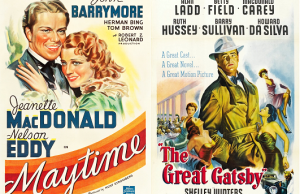Deadline U.S.A. (1952)
By Toronto Film Society on November 21, 2020
Toronto Film Society presented Deadline U.S.A. (1952) on Monday, February 19, 1990 in a double bill with While the City Sleeps as part of the Season 42 Monday Evening Film Buffs Series “B”, Programme 6.
Production Company: Twentieth-Century Fox. Producer: Sol C. Siegel. Director: Richard Brooks. Screenplay: Richard Brooks. Photography: Milton Krasner. Editor: William B. Murphy. Art Directors: Lyle Wheeler, George Patrick. Music: Cyril Mockridge. Musical Director: Lionel Newman.
Cast: Humphrey Bogart (Ed Hutcheson), Ethel Barrymore (Mrs. Garrison), Kim Hunter (Nora), Ed Begley (Frank Allen), Warren Stevens (Burrows), Paul Stewart (Thompson), Martin Gabel (Rienzi), Joseph De Santis (Schmidt), Joyce Mackenzie (Kitty Garrison Geary), Audrey Christie (Mrs. Willebrandt), Fay Baker (Alice Garrison Courtney), Jim Backus (Cleary), Carleton Young (Crane), Seimar Jackson (Williams), Kasia Orzazewski (Mrs. Schmidt).
Deadline U.S.A. is a film made late in Humphrey Bogart’s career, when what Ephraim Katz has called his “lonely, self-reliant, brooding, sardonic, skeptical and cynical image” was already well-established. The film’s director, Richard Brooks, had written the script for the 1948 Bogart/Bacall hit Key Largo (directed by John Huston) and tailored Bogart’s role in this later film to fit his star persona. Bogart plays Ed Hutcheson, editor of the Day, who learns that the heirs (widow and two daughters) of the late proprietor, John Garrison, plan to sell the paper to a rival who will close it down. Permission for the transfer has to be given in court and Hutcheson determines to fight the sale by proving the paper’s value and integrity; to this end, he launches an all-out attack on the powerful, shady Thomas Rienzi. The beating-up of one of the Day‘s reporters by Rienzi’s men and the discovery of Reinzi’s possible implication in the murder of a showgirl who had been his mistress provide ammunition. A reporter at last brings in a witness who can testify against Rienzi, but before he can sign his statement the gangster’s thugs murder him. Meanwhile, Mrs. Garrison (Ethel Barrymore) comes round to Hutcheson’s side and joins the fight to save the paper; in spite of this, the court rules that the sale must take place. Hutcheson returns to his office to find that the dead girl’s mother has brought in evidence which will ensure Rienzi’s conviction. In spite of Rienzi’s threats, Hutcheson orders the printing of the full story in his last edition.

Bosley Crowther, in his contemporary review in The New York Times, felt that Deadline U.S.A. presented “a quite authentic picture of a down-to-earth newspaper shop.” “The honest looks and dispositions of newspaper people are in this film,” he wrote, “from the gray heads of aging copyreaders to a standing skepticism toward cops. And a sense of the newsman’s strangely guarded dedication to his work is clear and keen.” Much of this is probably due to the fact that Richard Brooks, the film’s writer and director, began his career as a journalist and worked on the Philadelphia Record, a paper that folded as the one in the film does. In an interview with Movie, Brooks said that “the whole point” of Deadline U.S.A. was “that newspapers that bought out other newspapers and eliminated competition were creating a situation whereby a free press was curtailed….Now Darryl Zanuck was very concerned that this was going to be called a Communist kind of a thing. He said – “What do you mean, there is no free press?” I said – “I’m not saying that. I’m saying that this tendency leads in that direction.”
Kim Hunter plays Bogart’s wife in Deadline U.S.A. She had made an auspicious screen debut in the thriller The Seventh Victim (1943) and then worked with Michael Powell in A Canterbury Tale (1944) and A Matter of Life and Death (1946). Returning from England in 1947, she starred on Broadway as Stella Kowalski in “A Streetcar Named Desire” and won an Academy Award when she repeated the role in the 1951 film version. Deadline U.S.A. was her first film after this triumph. After only one more (Anything Can Happen (1952)) her name appeared in Red Channels, the Red-scare pamphlet, and she was blacklisted by the industry for several years. Her screen career was permanently damaged, though she did reappear in several “Planet of the Apes” movies in the late 1960’s.
Notes by Laurie McNeice
You may also like...
-
News

Frances Blau
Toronto Film Society | February 27, 2024On Monday, February 26th, 2024, Toronto Film Society lost longtime friend, supporter, and board member Frances Blau. Known for her sense of humour, her love of film, her generosity,...
-
Special Events

The Ladykillers (1955) at the Paradise Theatre
Toronto Film Society | March 9, 2024Toronto Film Society presents Targets (1968) at the Paradise Theatre on Sunday, April 7, 2024 at 2:30 p.m. Ealing Studios arguably reached its peak with this wonderfully hilarious and...
Programming

Virtual Saturday Night at the Movies
Toronto Film Society | April 11, 2024Toronto Film Society is back in the theatre! However, we’re still pleased to continue to bring you films straight to your home! Beginning Season 73 until now we have...
4-
 Toronto Film Society | March 9, 2024
Toronto Film Society | March 9, 2024
-
 Toronto Film Society | November 6, 2022
Toronto Film Society | November 6, 2022
-
 Toronto Film Society | August 1, 2023
Toronto Film Society | August 1, 2023
Donate to Toronto Film Society – We’re now a Registered Charity!
-
Copyright © 2017 Toronto Film Society.




Leave a Reply